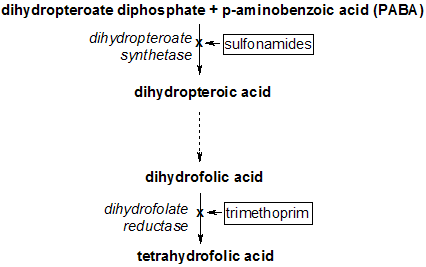Tetrahydrofolic acid
| Tetrahydrofolic acid | |
|---|---|
 | |
| IUPAC name (2S)-2-{[4-({[(6R)-2-amino-4-oxo-1,4,5,6,7,8-hexahydropteridin-6-yl]methyl}amino)phenyl]formamido}pentanedioic acid | |
| Identifiers | |
| CAS number | 135-16-0 |
| PubChem | 91443 |
| ChemSpider | 82572 |
| DrugBank | DB00116 |
| KEGG | C00101 |
| MeSH | 5,6,7,8-tetrahydrofolic+acid |
| ChEBI | CHEBI:20506 |
| Jmol-3D images | {{#if:O=C(O)[C@@H](NC(=O)c1ccc(cc1)NCC3N/C2=C(/N/C(=N\C2=O)N)NC3)CCC(=O)O|Image 1 |
| |
| |
| Properties | |
| Molecular formula | C19H23N7O6 |
| Molar mass | 445.43 g/mol |
| Except where noted otherwise, data are given for materials in their standard state (at 25 °C (77 °F), 100 kPa) | |
| Infobox references | |
Tetrahydrofolic acid, or tetrahydrofolate, is a folic acid derivative.
Metabolism

Human synthesis
It is produced from dihydrofolic acid by dihydrofolate reductase. This reaction is inhibited by methotrexate.
It is converted into 5,10-methylenetetrahydrofolate by serine hydroxymethyltransferase.
Bacterial synthesis
Many bacteria use dihydropteroate synthetase to produce dihydropteroate, a molecule without function in humans. This makes it a useful target for sulfonamide antibiotics, which compete with the PABA precursor.
Functions
It is a cofactor in many reactions, especially in the metabolism of amino acids and nucleic acids. It acts as a donor of a group with one carbon atom. It gets this carbon atom by sequestering formaldehyde produced in other processes. A shortage in THF can cause megaloblastic anemia.
Methotrexate acts on dihydrofolate reductase, like pyrimethamine or trimethoprim, as an inhibitor and thus reduces the amount of tetrahydrofolate made. This may result in megaloblastic anemia.
Tetrahydrofolic acid is involved in the conversion of formiminoglutamic acid to glutamic acid; this may reduce the amount of histidine available for decarboxylation and protein synthesis, and hence the urinary histamine and formiminoglutamic acid may be decreased.[1]
| |||||||||||||||||||||||||
References
- ↑ Dawson W, Maudsley DV, West GB (December 1965). "Histamine formation in guinea-pigs". J. Physiol. (Lond.) 181 (4): 801–9. PMC 1357684. PMID 5881255.
